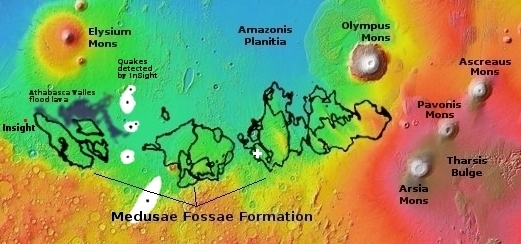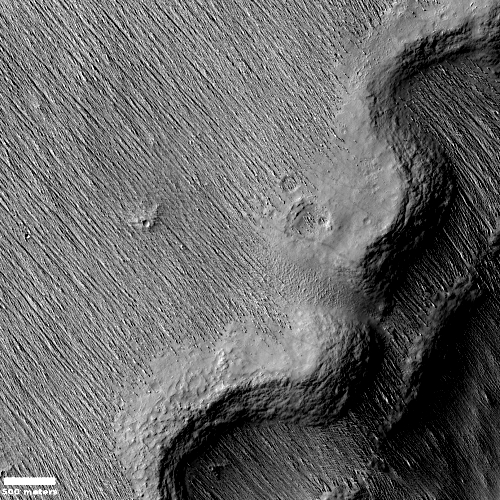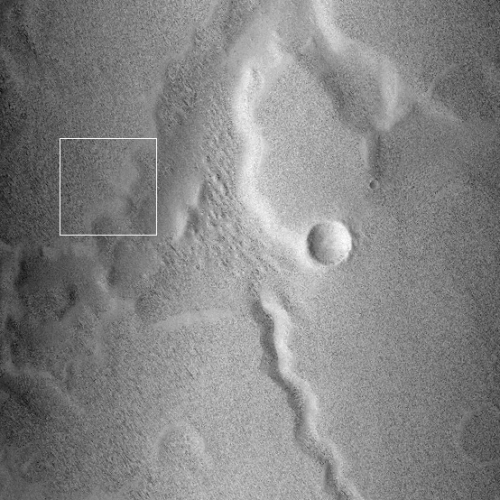The wind-swept volcanic ash plains of Mars

Cool image time! In Mars’ volcano country lies the planet’s largest ash deposit, dubbed the Medusae Fossae Formation. Scientists believe that this gigantic deposit, with a size comparable to the nation of India, was laid down by muliple volcanic eruptions over several billion years and is the source of most of the dust seen on the Red Planet.
The overview map on the right shows the location of this ash deposit on Mars. The white cross indicates the location of today’s cool image, found below.
The photo to the right, rotated, cropped, and enhanced to bring out the details, provides us a nice example of that ash deposit. Taken on May 10, 2021 by the high resolution camera on Mars Reconnaissance Orbiter (MRO), it shows how the prevailing southeast-to-northwest winds, weak as they are in the extremely thin Martian atmosphere, have in several billion years carved that ash deposit into a magnificent linear carpet.
Notice how the linear grooves remain aligned from terrace to terrace. Notice also how there is little dust or grooves at the cliff edges. This is especially pronounced in the full image, which also includes several areas where the grooves are less distinct as well as some smaller places where ridges are aligned at right angles.
This location, shown in the wider MRO context camera image below, is at the edge of a meandering gully suggestive of some sort of flow, usually assumed caused by liquid water but also by maybe water ice. The white box marks the area covered by the photo above.
The small many grooves at this spot also suggest that the ash deposit is somewhat thin. Compare it for example with the much larger grooves found near the deposit’s northern edge, about six hundred miles away. The difference suggests that the ash has been piling up to the north over time.
Only one other high resolution image has been taken by MRO near this location. Several miles to the south west, it only shows these linear grooves in its northeast quadant, suggesting it covers the edge of the ash deposit and reinforcing the impression that the ash is is very thin in the cool image above.
On Christmas Eve 1968 three Americans became the first humans to visit another world. What they did to celebrate was unexpected and profound, and will be remembered throughout all human history. Genesis: the Story of Apollo 8, Robert Zimmerman's classic history of humanity's first journey to another world, tells that story, and it is now available as both an ebook and an audiobook, both with a foreword by Valerie Anders and a new introduction by Robert Zimmerman.
The print edition can be purchased at Amazon or from any other book seller. If you want an autographed copy the price is $60 for the hardback and $45 for the paperback, plus $8 shipping for each. Go here for purchasing details. The ebook is available everywhere for $5.99 (before discount) at amazon, or direct from my ebook publisher, ebookit. If you buy it from ebookit you don't support the big tech companies and the author gets a bigger cut much sooner.
The audiobook is also available at all these vendors, and is also free with a 30-day trial membership to Audible.
"Not simply about one mission, [Genesis] is also the history of America's quest for the moon... Zimmerman has done a masterful job of tying disparate events together into a solid account of one of America's greatest human triumphs."--San Antonio Express-News

Cool image time! In Mars’ volcano country lies the planet’s largest ash deposit, dubbed the Medusae Fossae Formation. Scientists believe that this gigantic deposit, with a size comparable to the nation of India, was laid down by muliple volcanic eruptions over several billion years and is the source of most of the dust seen on the Red Planet.
The overview map on the right shows the location of this ash deposit on Mars. The white cross indicates the location of today’s cool image, found below.
The photo to the right, rotated, cropped, and enhanced to bring out the details, provides us a nice example of that ash deposit. Taken on May 10, 2021 by the high resolution camera on Mars Reconnaissance Orbiter (MRO), it shows how the prevailing southeast-to-northwest winds, weak as they are in the extremely thin Martian atmosphere, have in several billion years carved that ash deposit into a magnificent linear carpet.
Notice how the linear grooves remain aligned from terrace to terrace. Notice also how there is little dust or grooves at the cliff edges. This is especially pronounced in the full image, which also includes several areas where the grooves are less distinct as well as some smaller places where ridges are aligned at right angles.
This location, shown in the wider MRO context camera image below, is at the edge of a meandering gully suggestive of some sort of flow, usually assumed caused by liquid water but also by maybe water ice. The white box marks the area covered by the photo above.
The small many grooves at this spot also suggest that the ash deposit is somewhat thin. Compare it for example with the much larger grooves found near the deposit’s northern edge, about six hundred miles away. The difference suggests that the ash has been piling up to the north over time.
Only one other high resolution image has been taken by MRO near this location. Several miles to the south west, it only shows these linear grooves in its northeast quadant, suggesting it covers the edge of the ash deposit and reinforcing the impression that the ash is is very thin in the cool image above.
On Christmas Eve 1968 three Americans became the first humans to visit another world. What they did to celebrate was unexpected and profound, and will be remembered throughout all human history. Genesis: the Story of Apollo 8, Robert Zimmerman's classic history of humanity's first journey to another world, tells that story, and it is now available as both an ebook and an audiobook, both with a foreword by Valerie Anders and a new introduction by Robert Zimmerman.
The print edition can be purchased at Amazon or from any other book seller. If you want an autographed copy the price is $60 for the hardback and $45 for the paperback, plus $8 shipping for each. Go here for purchasing details. The ebook is available everywhere for $5.99 (before discount) at amazon, or direct from my ebook publisher, ebookit. If you buy it from ebookit you don't support the big tech companies and the author gets a bigger cut much sooner.
The audiobook is also available at all these vendors, and is also free with a 30-day trial membership to Audible.
"Not simply about one mission, [Genesis] is also the history of America's quest for the moon... Zimmerman has done a masterful job of tying disparate events together into a solid account of one of America's greatest human triumphs."--San Antonio Express-News




Notice also the eddies surrounding a central hill in the full-size image. Suggests very uniform wind direction over the entire area. Heck of a place to get lost in . . .